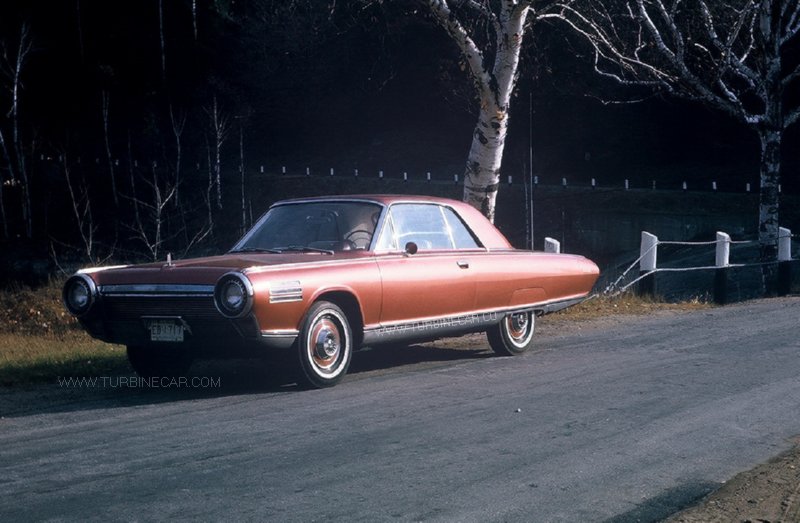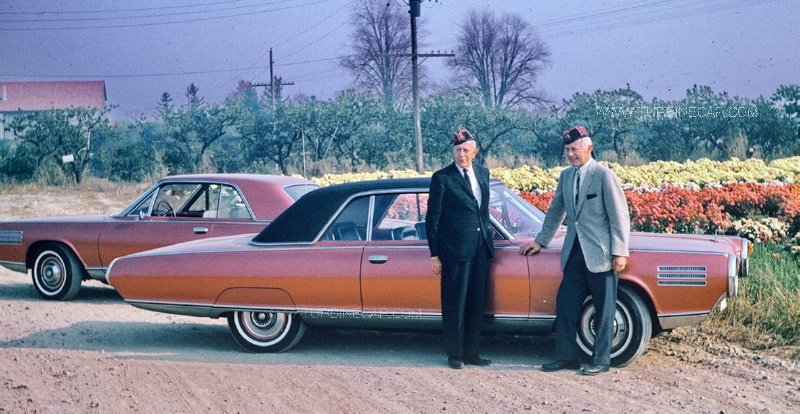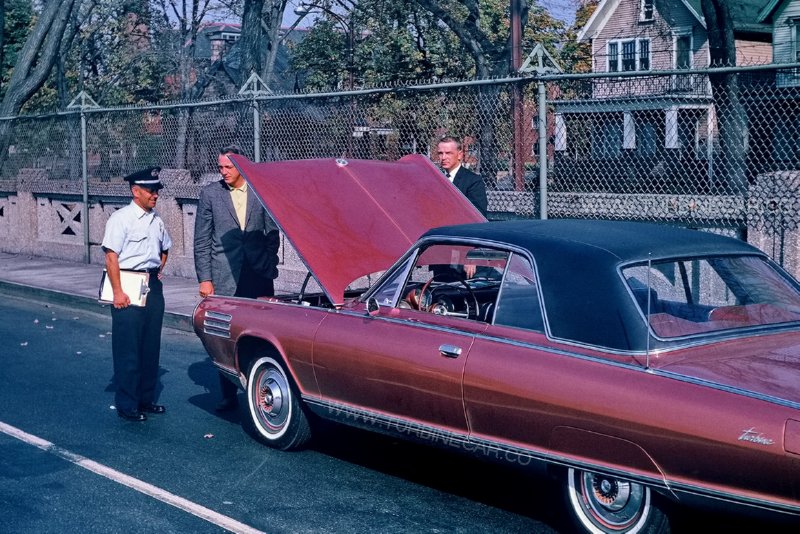|
Fred Wiggins and the turbine car transmission (and the shake-down trip) |
||
|
Fred Wiggins, transmission engineering Chrysler Corporation taken on turbine trip 1963 in New England. |
||
| Fred Wiggins joined Chrysler in
1953 and was immediately accepted to the Chrysler Institute where he earned a Masters of Engineering degree. In
the early 1960’s as an Automatic Transmission Specialist with the Chrysler Engineering Center, he was responsible
for the development of advanced transmissions and components. In 1961, Fred was assigned the job to design, develop and supervise the assembly of the automatic transmission for the then planned 50 turbine cars user program. The engineering team decided that the transmission for the Ghia cars would be a modification of the A727 “Torqueflite 8” transmission. The turbine transmission would not need the normal torque converter as the power output turbine functioned as a torque converter being stalled at idle and spinning up as the throttle increased. The addition of reduction gears (10 to 1 ratio) was needed because the power turbine was capable of a maximum speed of over 40,000 R.P.M. which was much too fast for any transmission input shaft to handle. Because Another modification was the use of a single pump, this replaced the normal front and rear pumps and was driven by the gas generator accessory drive. That pump drew type A transmission fluid from the transmission sump. This pump was the supply source for the combined lubrication and the hydraulic system in the transmission. That one pump was also used for the gas turbine lubrication along with the power steering. The transmission case was modified by removing the torque converter bell housing. A cast iron adapter plate replaced the front pump housing. That plate also served as the mounting plate to the turbine engine. The transmission control system required many modifications. The turbine engine compressor pressure was used as an indication of its output and the transmission line pressure was modulated accordingly. How the pressure was modulated in relation to the turbine engine’s compressor pressure has a true “rest of the story” much like Paul Harvey. Fred found that a small valve body was needed to make that work. The transmission lab where Fred worked also would purchase transmissions from all the big three makers and take them apart to see how the competition did the job. Looking over a Lincoln automatic transmission they had there in the lab, he found the exact small valve and body they needed. In contacting a local Lincoln dealer’s parts department he was told that the small sub-assembly was only sold as part of the complete valve body. Fred made a call to an engineer he knew at the Ford transmission plant to see if he could help. His friend informed Fred that their plant had a large box of valve body assemblies and were about to scrap them. Fred made a quick trip over to the Livonia plant and his friend gave him enough valve body assemblies for Chrysler to build all the transmissions needed for the fifty car program. Few people other than our engineering procurement man and Fred were aware that the turbine automatic transmission had a FoMoCo part in it. The manual shift valve was also changed to eliminate neutral, locking the transmission by engaging forward and reverse elements simultaneously for a "Start-Park and Idle". The manual shift lever position of '"Low” allowed an automatic up shift for power turbine over speed protection. The transmission gear train was unchanged. The band capacity for the I - 2 shift and the clutch capacity for the 2 - 3 shift had to be changed considerably because the turbine was a torque monster capable of producing 450 foot pounds at idle. Fred had the opportunity to go on two road trips with the Turbine Cars. On the first trip they went to Mount Washington in the State of New Hampshire. On the Second trip they went to Loveland Pass in Colorado. You can imagine the attention the cars created as they crossed the countryside. Fred was responsible for adapting the automatic transmission to not only the gas turbine, but diesel, rotary and race engines. Fred and his design team developed the Torqueflite transmission for the hemi engine which became the established performance and durability leader at the drag strip. In 1969 Fred was promoted to Manager of Resident Engineering and Quality Control at the Chrysler Detroit Axle Plant where he worked until his retirement in 1988. Fred rejoined Chrysler later that year, this time as a consultant to Central Engineering as the Product Coordinator of Drive Train for the minivan all wheel drive program. He retired again six years later for a total of 43 years of service. Fred was just one of the many talented and dedicated engineers and designers who gave their best effort to make the program a success. |
||
|
These following photos are provided through the generosity of Fred Wiggins with the help of his son. |
||
|
The above photo was taken by Fred in New England during the road trip he went on. Notice the second car is one of the five engineering cars as is probably the front car. This was before the user program started and was a "shake down" trip to see if the cars were ready for prime time. Also notice both cars had their radio antenna extended as far as they woutd go - the turbine car had only AM radio and there were not many stations up in that area. (from the Fred Wiggins collection) |
||
|
The above photo of the all bronze car is one of the most interesting of all that Fred took. Today a half a decade later, we see can see what might have been one of the options and in some ways, I like the all bronze car a lot. In the detailed photos the Turbine script is not on the Left side for sure. Neither of the cars appear to have the emblem on the Left side of the hood either. |
||
|
Can you imagine the driver of the Olds - Wow! A turbine car - wait there is another one! |
||
|
This photo was taken by Fred when they stopped about half way up Mount Washington. From Left to Right - Ray Eady - George Carley - John O'brien - unknown - George Huebner - Tom Gleason - Al Bell - Bill Carry |
||
|
This photo was taken by one of the other members of the group so Fred could get into the shot. From Left to Right - Al Bell - George Carley - George Heubner - Fred Wiggins - Tom Gleason - Ray Eady - Bill Carry
Bill Carry - Fred Wiggins - Al Bell - George Heubner - John O'Brien - Bill Drinkard - Ray Eady - bystander in background. At one of the places the group stayed during the trip. |
||
|
This photo was taken by Fred near the top of Mt. Washington. In this view of the Left side of the first car you can still see that the Turbine name in script was applied while it is not visible in any of the photos of the Right side. |
||
|
This photo was taken by Fred and clears up some questions I have had over the years. If you will notice the car with the vinyl roof in the foreground is missing the emblem on the rear fender and it has black seats. That would be the very first prototype car that I have video of the delivery and un-crating of. You will notice the car in the back has white seats so this must be the second prototype without the vinyl roof and white interior. This car was seen in a photo in the labs without any interior at all later in the program. The white car used in the movie and tested by Tom MacHill (see article here) had bronze seats with white insert panels. The other two prototype cars were exactly like the fifty loaned to users. The man on the right is George Heubner - I have not identified the man on the left. |
||
|
This photo was taken by Fred at a garage they stopped at. George Huebner is on the Left, Tom Gleason next to him and Bill Carry is working on the all bronze car in the background. |
||
|
This is another photo taken on the New England trip when crossing into or return from Canada. The customs officer is on the Left and John O'Brien and Al Bell are to his Right |
||
Page updated 4/19/2011










